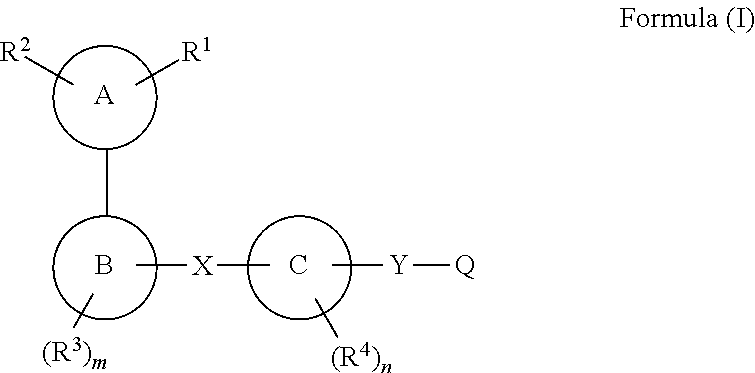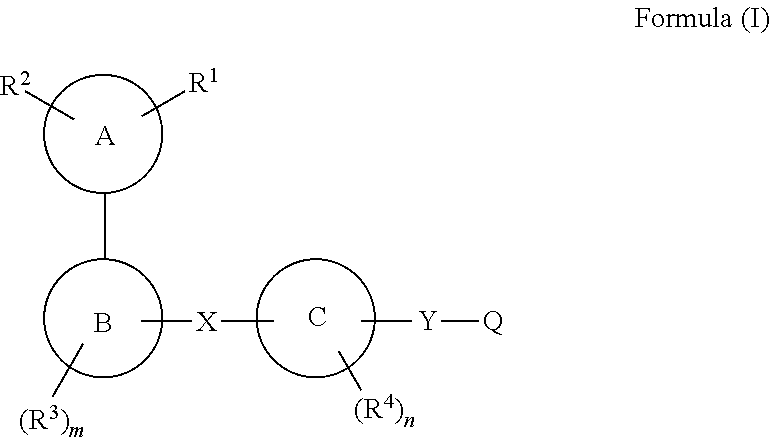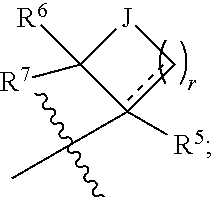Compounds for use as gpr120 agonists
a technology of compound and agonist, which is applied in the field of compound, can solve the problems of hyperglycemia, increased blood and urine glucose (hyperglycemia), and inability to produce enough insulin,
- Summary
- Abstract
- Description
- Claims
- Application Information
AI Technical Summary
Benefits of technology
Problems solved by technology
Method used
Image
Examples
embodiments
[0098]According to one embodiment, the present invention encompasses a compound of Formula (I); wherein[0099]R1 is
wherein[0100] is point of attachment to ring A;[0101]J is —CH2—, —CHF—, —CF2—, —CH[(C1-C6)alkyl]-, —C[(C1-C6)alkyl]2-, —O—, —NRa— or —S—;[0102]“-----” represents an optional bond;[0103]Ra is hydrogen, (C1-C6)alkyl or halo(C1-C6)alkyl;
[0104]R2 is independently selected from the group consisting of hydrogen, halogen, (C1-C6)alkyl, halo(C1-C6)alkyl, (C3-C10)cycloalkyl, (C6-C10)aryl, heteroaryl, heterocyclyl, (C6-C10)aryl-(C1-C6) alkyl, (C1-C6)alkyl-(C6-C10)aryl-, heterocyclyl-(C -C6)alkyl-, (C1-C6)alkyl-heterocyclyl, heteroaryl-(C1-C6)alkyl-, (C1-C6)alkyl-heteroaryl-, cyano, —C(O)NR10R11, —C(S)NR10R11, —S(O)tR12 and —C(O)R13;
[0105]R5, R6, R7 and r are as defined above.
[0106]According to one embodiment, the present invention encompasses a compound of Formula (I); wherein:
R1 and R2 are combined together with one or two atoms of Ring A to form:[0107]i) a 3- to 8-membered, part...
example 1
4-(4-((2-(5-(1-Cyanocyclopropyl)thiophen-2-yl)-5-fluorobenzyl)oxy)phenyl)butanoic acid
Step 1a
Synthesis of methyl-4-(4-((2-bromo-5-fluorobenzyl)oxy)phenyl)butanoate
[0351]According to general procedure A (as described herein above), 1-bromo-2-(bromomethyl)-4-fluorobenzene (1 g, 3.73 mM), was coupled with methyl 4-(4-hydroxyphenyl)butanoate (0.797 g, 4.11 mM), to give the title compound, methyl 4-(4-((2-bromo-5-fluorobenzyl)oxy)phenyl)butanoate. Yield: 1.39 g, 3.65 mM, 98%; 1H NMR (CDCl3, 500 MHz) δ 7.52-7.58 (m, 1H), 7.20-7.38 (m, 1H), 7.13 (d, J=8.5 Hz, 2H), 6.98-6.96 (m, 3H), 5.08 (s, 2H), 3.68 (s, 3H), 2.62 (t, J=8 Hz, 2H), 2.34 (t, J=7.5 Hz, 2H), 1.90-2.0 (m, 2H); MS (m / z); 404.2 [M+Na+].
Step 1b
Synthesis of methyl 4-(4-((5-fluoro-2-(4,4,5,5-tetramethyl-1,3,2-dioxaborolan-2-yl)benzyl)oxy)phenyl)butanoate
[0352]The compound obtained in step 1a, methyl 4-(4-((2-bromo-5-fluorobenzyl)oxy)phenyl)butanoate (1.5 g, 3.93 mM), was coupled with bis(pinacolato)diboron (1.49 g, 5.90 mM) in the ...
example 2
3-(4-((2-(5-(1-Cyanocyclopropyl)thiophen-2-yl)-5-fluorobenzyl)oxy)phenyl)propanoic acid
Step 2a
Synthesis of ethyl 3-(4-((2-bromo-5-fluorobenzyl)oxy)phenyl)propanoate
[0355]According to general procedure A(as described herein above), 1-bromo-2-(bromomethyl)-4-fluorobenzene (1.517 g, 5.66 mM) was coupled with ethyl 3-(4-hydroxyphenyl)propanoate (1 g, 5.15 mM), to give the title compound, ethyl 3-(4-((2-bromo-5-fluorobenzyl)oxy)phenyl)propanoate. Yield: 1.6 g, 4.20 mM, 82%; 1H NMR (CDCl3, 300 MHz) δ 7.50-7.60 (m, 1H), 7.30-7.38 (m, 1H), 7.1 (d, J=8.4 Hz, 2H), 6.80-7.00 (m, 3H), 5.07 (s, 2H), 4.13 (q, J=7.2 Hz, 2H), 2.92 (t, J=7.5 Hz, 2H), 2.60 (t, J=7.8 Hz, 2H), 1.25 (t, J=7.2 Hz, 3H); MS(m / z) 382.3 [M+H+].
Step 2b
Synthesis of ethyl 3-(4-((5-fluoro-2-(4,4,5,5-tetramethyl-1,3,2-dioxaborolan-2-yl)benzyl)oxy)phenyl)propanoate
[0356]The compound obtained in step 2a, ethyl 3-(4-((2-bromo-5-fluorobenzyl)oxy)phenyl)propanoate (1.5 g, 3.93 mM), was coupled with bis(pinacolato)diboron (1.499 g, 5.9...
PUM
| Property | Measurement | Unit |
|---|---|---|
| Force | aaaaa | aaaaa |
| Force | aaaaa | aaaaa |
| Force | aaaaa | aaaaa |
Abstract
Description
Claims
Application Information
 Login to View More
Login to View More - R&D
- Intellectual Property
- Life Sciences
- Materials
- Tech Scout
- Unparalleled Data Quality
- Higher Quality Content
- 60% Fewer Hallucinations
Browse by: Latest US Patents, China's latest patents, Technical Efficacy Thesaurus, Application Domain, Technology Topic, Popular Technical Reports.
© 2025 PatSnap. All rights reserved.Legal|Privacy policy|Modern Slavery Act Transparency Statement|Sitemap|About US| Contact US: help@patsnap.com



